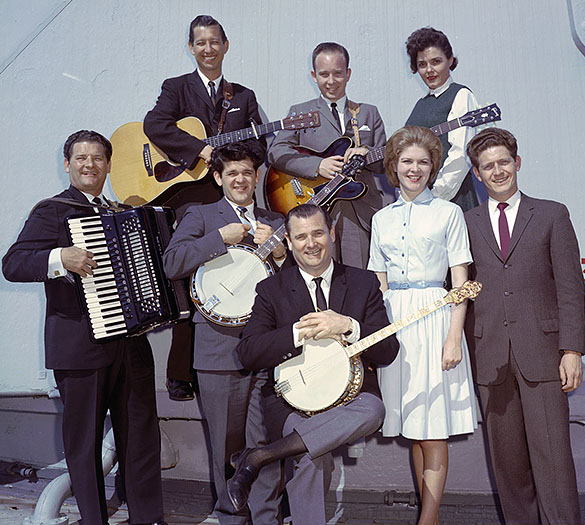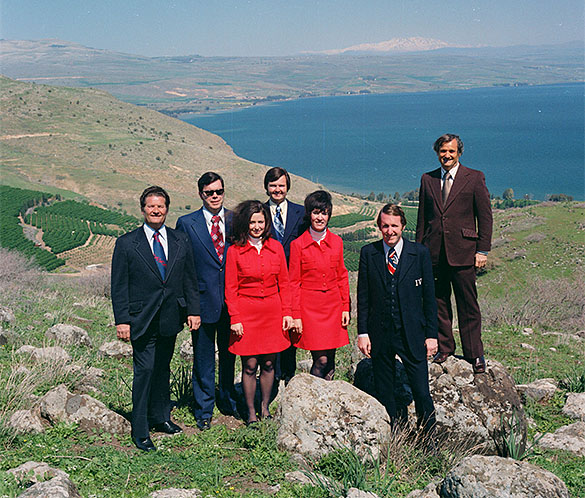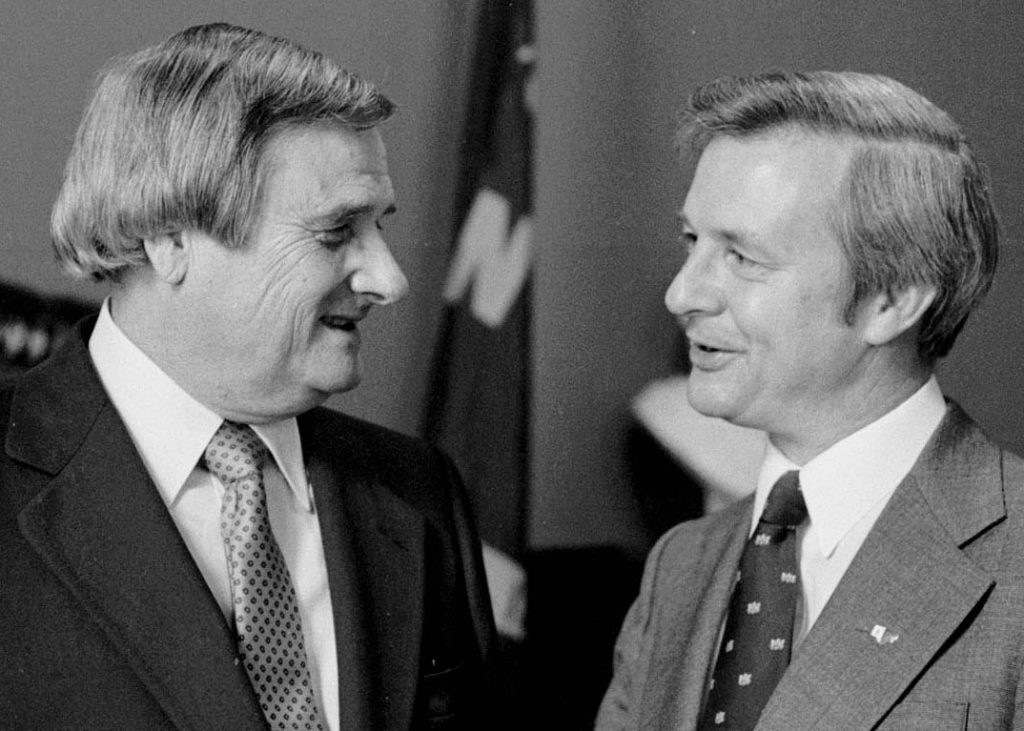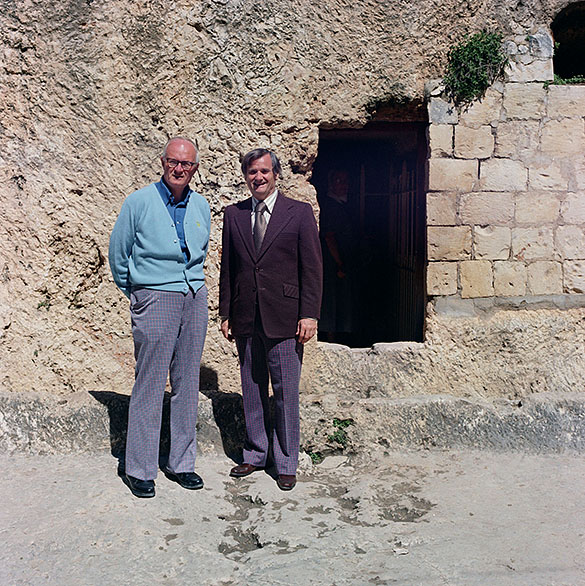In February we shared a blog-post about the special connection that Hugh Morton had with Legendary UNC Basketball Coach Dean Smith. Today, April 3, 2015, on the one-year anniversary of the death of another legend named Smith, Morton Collection volunteer Jack Hilliard shares the special connection Hugh Morton had with Music Legend Arthur Smith. In case you landed here first, be sure to check out today’s other post on Arthur Smith by Stephen Fletcher, the second half of today’s doubleheader.

When the folks at Grandfather Mountain staged their 90th Singing on the Mountain festival on June 22, 2014, they dedicated the event to Arthur Smith. Smith had passed away a little over two months before on April 3rd, just two days after his 93rd birthday.
Smith and his “Crackerjacks” had served as Music Masters of the event from about 1950 through the early 1980s. I think it’s safe to say that Smith had a standing invitation from his dear friend Hugh Morton to be a part of every Singing on the Mountain. During the 1960s and ‘70s, Smith was responsible for inviting his friends Johnny and June Carter Cash in 1974 and Rev. Billy Graham in 1962, plus many other famous names. Smith was the featured speaker at the 1991 event.
The 2014 speaker was noted evangelist Leighton Ford who had been the main speaker at the event in 1969 and 1989. Ford built his ‘14 message around the words of some of the gospel songs Smith had written over the years. In an interview before the event, Ford said, “I do plan to include some of Arthur’s songs and thoughts in this, because our faith is a singing faith.” Legendary Charlotte television broadcaster Doug Mayes introduced Rev. Ford. Mayes had helped Clyde McLean serve as the chief announcer on The Arthur Smith Show, which was taped at WBTV, Channel 3 in the Queen City. Mayes also shared some of his memories of Smith and the “Crackerjacks.
The 2014 musical lineup included a noon tribute to Smith by his son, Clay, and “Brother Ralph” Smith’s sons, Tim and Roddy, playing instrumentals with David Moody of The Moody Brothers. Vocalist Keith Dudley offered several of Smith’s most well-known hymns, and George Hamilton IV, who performed with Smith for years, came in from Nashville and his job as backstage host of the Grand Ole Opry to sing Smith’s most famous hymn, “Acres of Diamonds.” The Cockman Family of Sherrills Ford, NC added several of Smith’s secular hits including “Feudin’ Banjos” and “Guitar Boogie.”
*****

Arthur Smith and Hugh Morton go back a long way. There are pictures in the Morton Online Collection of Smith and his “Crackerjacks” at the 1952 Azalea Festival in Wilmington and a decade or so later on the deck of the Battleship USS North Carolina. But it was in 1962 that the Morton–Smith “team” set out on its most famous project.
In the mid-1950s, the National Park Service was preparing for the final 7.7 miles of the Blue Ridge Parkway and the state planned to gain, by its power of eminent domain, a portion of Grandfather Mountain in order to build a road higher on the Mountain than Morton wanted. Here’s how Morton described the situation in his 1988 book, Making a Difference in North Carolina:
To accommodate the requested “high route,” the state condemned additional land and we protested to Chairman A.H. Graham of the North Carolina Highway and Public Works Commission. . . The Chairman promptly arranged for a hearing before the State Highway Commission for the National Parks Service and me.
Almost immediately I received an invitation from WRAL-TV, in Raleigh, to debate the Grandfather Mountain right-of-way controversy with National Parks Director (Conrad) Wirth. . . Later I was notified that Wirth was bringing his engineer, and suggested I bring my engineer or lawyer to even up the sides of the debate. I had neither engineer nor lawyer. So I invited my friend Arthur Smith . . .
Wirth obviously did not know Arthur Smith when I introduced them, and was unaware that he performed daily in nearly every television market in the southeastern United States, including WRAL-TV. The Park Director and his engineer spoke first. . . I made a brief statement and then Arthur Smith, in his Southern drawl said, “When a man like Hugh Morton owns a mountain and loves it like he does, it don’t seem right for a big bureaucrat to come down here from Washington and take it away from him.”
The telephone switchboard at WRAL-TV lit up with support for our position and it was soon obvious that Conrad Wirth had lost the debate. . . . The State Highway Commission voted to return the illegally condemned land.
*****
Hugh Morton almost never promoted himself, but he did try once, with a little help from a few of his friends. Hugh’s longtime friend Charles Kuralt described the start of that effort at the 1996 North Caroliniana Society Award ceremony.
On December 1, 1971, in the shadow of the Capitol in Raleigh, surrounded on a chilly day, by shivering pretty girls in shorts wearing “Morton for Governor” hats and carrying “Morton for Governor” signs, with Arthur Smith playing “Guitar Boogie” for the crowd, with Charlie “Choo Choo” Justice on hand to declare “I have been on Hugh’s team all my life,” Hugh Morton formally declared his candidacy for governor.
Morton chose to withdraw his candidacy a couple of months later. It was likely the only occasion when the Morton–Smith duo failed to achieve its goal.
*****

In March of 1973, Arthur Smith took his syndicated television program to the Holy Land to record shows in Nazareth, Jericho, Mt. Sinai, Jerusalem, Bethlehem, and of course at the River Jordan. The group also visited Rome. Morton, along with wife Julia and daughter Catherine, went along to take photographs that were later used for album covers.
*****
 North Carolina Governor Jim Hunt called Hugh Morton in March of 1981. The Governor wanted a 3-cents-a-gallon gasoline tax to finance road improvements. Morton, as always, stepped in to help. Hunt had polling data that said support for the gas tax was weakest among blue collar workers and farmers. The Governor’s plan called for Morton and retired Charlotte banker C.C. Hope to lead an effort to change the opinion of that segment of the population. Well, Hugh Morton had better idea. Rather than banker Hope, why not recruit Arthur Smith? Morton believed that a country music legend like Smith would do better than a banker when trying to convince blue collar workers and farmers to support a gas tax. Smith agreed to take on the challenge. The plan worked; on June 26, 1981, the legislature approved the tax.
North Carolina Governor Jim Hunt called Hugh Morton in March of 1981. The Governor wanted a 3-cents-a-gallon gasoline tax to finance road improvements. Morton, as always, stepped in to help. Hunt had polling data that said support for the gas tax was weakest among blue collar workers and farmers. The Governor’s plan called for Morton and retired Charlotte banker C.C. Hope to lead an effort to change the opinion of that segment of the population. Well, Hugh Morton had better idea. Rather than banker Hope, why not recruit Arthur Smith? Morton believed that a country music legend like Smith would do better than a banker when trying to convince blue collar workers and farmers to support a gas tax. Smith agreed to take on the challenge. The plan worked; on June 26, 1981, the legislature approved the tax.
Also in 1981, Morton completed work on the award-winning film The Hawk and John McNeely. The music track for that film was done by Arthur Smith and the film was narrated by Woody Durham, “The Voice of the North Carolina Tar Heels” football and basketball teams.
*****

It was a beautiful September day in 1987 when the Blue Ridge Parkway was officially opened for traffic to travel the entire 469.1 miles through 29 Virginia and North Carolina counties. The dedication ceremony brought together again Arthur Smith and Hugh Morton. They had come full circle, from that famous debate 25 years before in Raleigh, to the official dedication at the Linn Cove Viaduct on September 11, 1987.
*****
Almost five years later, on September 2, 1992, another celebration took place at Grandfather Mountain. This time it was the 40th anniversary of the Mile High Swinging Bridge. Many familiar faces turned out for this party as well: Kuralt, Justice, and of course Arthur Smith with guitar in hand to entertain the crowd.
Arthur Smith was best known for his music, but he was a serious Bible student and Sunday school teacher throughout his career. In a January, 1992 book titled Apply it to Life, he shared his practical applications of the Scriptures. By combining his favorite verses of Scripture, humorous stories that he had collected over the years, and ten of his most popular inspirational songs, he was effectively able to apply the messages found in Scripture to one’s everyday life.
“He had a very strong faith and considered being the musical host for the ‘Singing on the Mountain’ to be part of his ministry,” said Harris Prevost, vice president of the Grandfather Mountain Stewardship Foundation.
According to Hugh’s wife Julia, Hugh and Arthur had only one serious disagreement during their long friendship. That disagreement came during the campaign to get “Liquor by the Drink” in North Carolina. Both men were teetotalers, but Morton saw the tourist value in Liquor by the Drink and fought hard to get it approved. He was finally successful in 1978 without Smith’s support, but he never lost Smith’s respect.
*****
From Swinging on the Bridge to Singing on the Mountain . . . from the Azalea Gardens in Wilmington to the Holy Land and Rome . . . from the Deck of the “Showboat” to the Linn Cove Viaduct . . . Hugh Morton and Arthur Smith stood shoulder-to-shoulder carrying out numerous projects and celebrating others across the state of North Carolina for more than 50 years. And on this day, one year after Arthur Smith joined Hugh Morton once again, I choose to believe that their special connection continues.

Epilogue:
When The Levine Museum of the New South in Charlotte published its 2002 book The North Carolina Century: Tar Heels Who Made a Difference, 1900-2000, they chose a Hugh Morton portrait of Arthur Smith to support the Smith profile.

George Hamilton IV will be honored at the 91st Singing on the Mountain on June 28th 2015.
http://www.hcpress.com/festivals/annual-singing-on-the-mountain-at-grandfather-to-recognize-musician-george-hamilton-iv.html
Whatever happened to Carlene Sam Howell who was with Arthur Smith?
Mr. Smith,
I worked at WBTV when Carlene was their and would appreciate knowing what became of her after she left Arthur.
Thank you, sir.
John Reichard